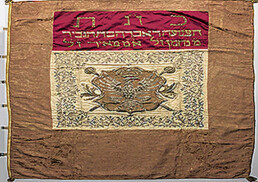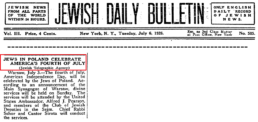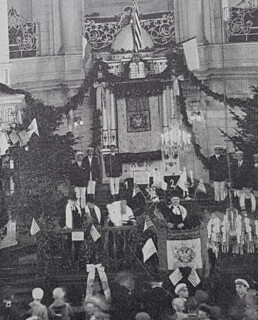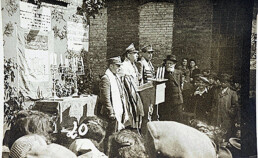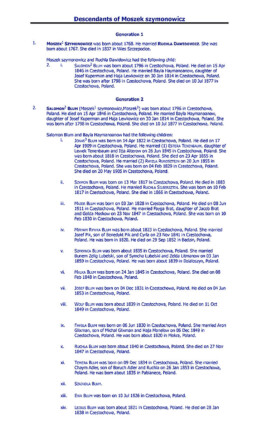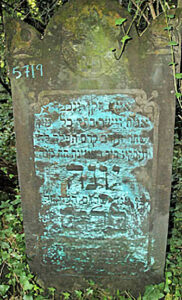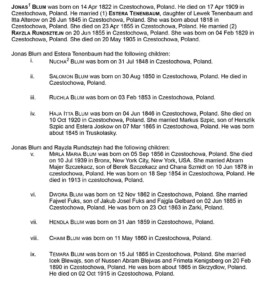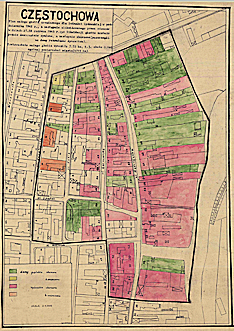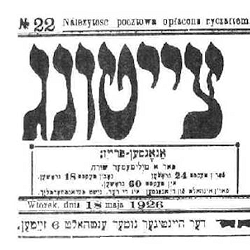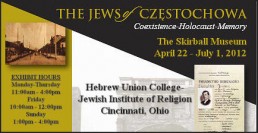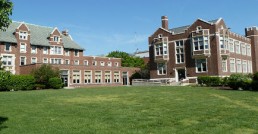The Parochet and Napoleon's Flag in the Synagogues of Częstochowa
The Parochet and Napoleon's Flag
in the Synagogues of Częstochowa
INTRODUCTION
Collections of stories and family gossip often open up new directions for exploring a family’s roots.
One afternoon, while talking with my cousin Matt Shakter and updating the Szczekacz family branch, Matt said:
“I have a two hundred year old story to tell you. In our family, the story has passed from one generation to the next.
“When Napoleon retreated from Moscow, his military units passed through Częstochowa. Before he left, one of the French officers gave a woman, from our family, a French flag as a souvenir. The woman kept the flag, which was later made into a Parochet, the curtain of the Aron Ha-Kodesh [the ark hold the Torah scrolls], and donated it to the Old Synagogue in memory of a family member. According to the story, the flag-Parochet also appeared on occasions when there were military parades in the city.”
Could this tale of a two-hundred-year-old Parochet be true, or was it just a myth that ran in the family?
My young sister, Ofra, remembered a similar story in Alon Goldman’s newsletter.
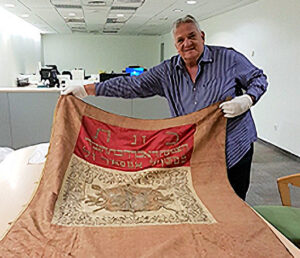 Alon Goldman (pictured left, with the parochet) is the Chairman of the Association of Częstochowa Jews in Israel and Vice-President of the World Society of Częstochowa Jews and their Descendants. He is closely involved in the restoration of the Częstochowa Jewish Cemetery and with Jewish cultural and memorial events in Częstochowa. He often travels to Częstochowa and publishes the Częstochowa Association newsletter.
Alon Goldman (pictured left, with the parochet) is the Chairman of the Association of Częstochowa Jews in Israel and Vice-President of the World Society of Częstochowa Jews and their Descendants. He is closely involved in the restoration of the Częstochowa Jewish Cemetery and with Jewish cultural and memorial events in Częstochowa. He often travels to Częstochowa and publishes the Częstochowa Association newsletter.
THE PAROCHET’S HISTORY
1813-1863
Alon Goldman tells of two Polish regimental flags which were sewn to make Parochets for the holy ark housing the Torah scrolls of the Częstochowa Old Synagogue [See note 1 below]. Each Parochet had a embroidered family inscription.
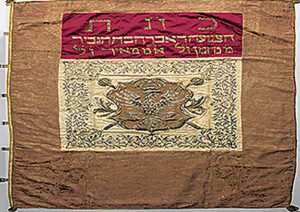 One Parochet was in memory of Dvora daughter of Nachman, wife of Meir.
One Parochet was in memory of Dvora daughter of Nachman, wife of Meir.
The curtain is 137cm long and 115cm wide. The front facade is made of a bright, light-brown damask silk with a white flag at the centre. The flag has an embroidery of a shield, an eagle, with spread wings and legs, and a crown. Above the flag, there is a rectangular piece of satin, embroidered with the Hebrew dedication:
כ ז״נ ת
הצנועה דאברהבתהגביר
מ׳ נחמן ז״ל אמ מאיר ז״ל
The details in Hebrew:
כתר זה נדבת תורה
הצנועה של דאברה בת הגביר
נחמן ז״ל אשת מאיר ז״ל
“Crown of Torah
This is a donation of the modest Dobra, daughter of the opulent Mr. Nachman z”l[See Note 2 below]
wife of Mr. Meir’s z”l”
Alon Goldman mentions a second flag that was made into a Parochet, in memory of Chaya, wife of Yosef Heiman.
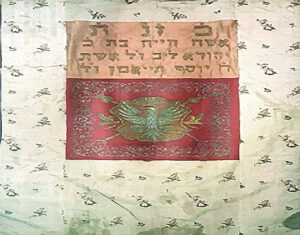
The second Parochet is 185 cm long and 130 cm wide.
An eagle with its wings and legs spread and a crown on its head is embroidered on a shield at the center of the red canvas.
The canvas on the other side of the Parochet is damaged.
The Hebrew inscription is:
כ‘ ז”נ ת
אשה חייה בת כ
יהודא ליב ז”ל אשת
ר’ יוסף הייאמן ז”ל
The details in Hebrew are:
כתר זה נדבת תורה
אשה חייה בת כבוד
יהודא ליב ז”ל אשת
ר’בי יוסף הייאמן ז”ל
“Chaya daughter of Yehuda Leib z”l the wife of Yosef Heiman”
The identities of the two women mentioned on the Parochets remain a mystery, because no surnames are known for them, for their husbands or for their fathers. Alon Goldman believes that the Parochets were donated to the synagogues by relatives from the same family. He quotes evidence from an article from the Częstochowa edition of Gazeta Wybora, dated 5th May 2016, “Napoleonic Banners in the Synagogue in Częstochowa” by Jarosław Sobokowski:
According to Sobokowski, during Napoleon’s retreat from Moscow in the winter of 1813, Napoleon’s starving troops arrived in Częstochowa around 24th-25th March. Several of the officers rested at Meir Blum’s Red House Inn in the Stary Rynek [Old Market Square], when a siren warned of the approach of the Russian enemy. The French, followed by the Poles, hastily fled the city and left behind two flags. Meir Blum, the innkeeper, managed to hide these flags, symbols of independent Poland, from the Russian troops.
When the two flags were made into the Parochets, one was inscribed to Meir Blum’s wife, the daughter of Nachman, and the second to the mother of his daughter-in-law, Chaja, wife of Josef Hajman.
My cousin Matt’s story told of a French flag given to the Szczekacz family, while Alon Goldman refers to a Polish flag dedicated to women from Blum family. Abram Majer Szczekacz, Matt’s grandfather, married a Mirla Blum. Could the Polish flag, turned Parochet, be the French flag from Matt’s family story? Is Mirla Blum, who married Abram Majer Szczekacz on 10th June 1878 in Częstochowa, related to Meir Blum, the 1813 innkeeper? Can we match people on our family tree with the names on the inscriptions on the two Parochets?
The Polish flags, turned into Parochets, hidden for half a century (1813-1863) by the family of Meir Blum the innkeeper, reappear in the Częstochowa Old Synagogue during the brief Polish uprising against Russia in 1863. According to Jarosław Sobokowski, after the uprising failed, the Parochets were hidden again, for fifty-three years, by a prominent, but unnamed family, for fear of looting by the Russian occupier.
The same story about the flags appears in Vila Orbach’s book, “The History of the Jews of Częstochowa” [See Note 3 below].
A photo [See Note 4 below] and a brief sentence about the flags-Parochets appear in the “The Jews in Częstochowa to World War I” by Dr. Yaakov Shatzki.
1916
Sobokowski continues:
The flags were taken out of their hidden place on 3rd May 1916. The celebration, on that day, was exceptional in Częstochowa. The city, occupied for almost two years by the German army, did not seem to remember war and enslavement. White and red banners, the colors of the Polish flag, were raised in the city and “Goniec Częstochowski”, the most important local Częstochowa newspaper at the time, advised how to sew a Polish flag from two pieces of white and red canvas.
The Jews also celebrated 3rd May 1916 in the synagogue. They had the two Polish banners that have been already turned into Parochets. “Goniec Częstochowski” notices this and describes the uniqueness of these banners. [See Note 5 below] The newspaper was translated [See Note 6 below] for the essay by Jan Gronski.
1926
Both Parochets can be seen in the New Synagogue [See Note 7 below], which was built in 1893 on the corner of ul. Wilsona (formerly ul. Aleksandrowska) and ul. Garibaldiego. The Parochets were on loan to the New Synagogue for the celebration of the 150th anniversary of USA independence.
In 1926, the United States marked the sesquicentennial of the signing of the Declaration of Independence with a major celebration. So, too, did Poland which had, itself, only regained its independence in 1918, with significant U.S. support. Polish efforts to celebrate U.S. independence culminated in October 1926 with the presentation, to President Calvin Coolidge, of over 111 volumes of greetings from the people of Poland and a gold medal [See Note 8 below]. The gift was called “A Polish Declaration of Admiration and Friendship for the United States of America”. These volumes consisted of a declaration of admiration signed by an estimated 5,500,000 Polish citizens, representing more than one- sixth of the total population of Poland in 1926 [See Note 9 below].
The Jewish community, together with Polish nation, celebrated the 150th anniversary of United States [See Note 10 below] Independence.
The Jewish Daily Bulletin announced the 150th United States Independence Day celebrations:
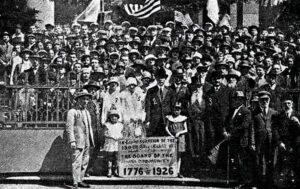
Above: Following the 150th United States Independence Day celebrations, Rabbi Nahum Asz stands next to the New Synagogue’s gate. Next to him are S. Goldsztajn, Ch. Weksler, M. Asz, M. Sudowicz, D. Filipowicz, J. S. Koblenz, B. Bocian, J. Kopin, A. Sigman and guests from the United States.
Left: Cantor Fiszel leading the prayer service in the Częstochowa New Synagogue.
1939-1946
On 3rd September 1939, the Germans occupied Częstochowa.
On 25th September 1939, the Germans, aided by a Polish mob, ravaged the Old Synagogue. In 1943, it was finally destroyed by the Nazis during the liquidation of the “Small Ghetto”.
The New Synagogue was set on fire by German military policemen, assisted by their Volksdeutsch henchmen, on Christmas Day, 25th December 1939.
It was thought that the Parochets shared the fate of the synagogues [See Note 11 below] and the tragic fate of the Jewish people and that they disappeared in the rubble of the temples.
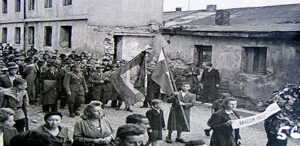 After the liberation of Częstochowa, however, the Parochets were miraculously recovered. A photograph (left) by Lew Kusznir, from 1945 or 1946, shows one Parochet carried as a flag in the forefront of a march along ul. Spadkowa and ul. Kozia in Częstochowa. The march was to honour the exhumation of the bodies of Jewish victims and their burial in the Jewish cemetery. [See Note 12 below]
After the liberation of Częstochowa, however, the Parochets were miraculously recovered. A photograph (left) by Lew Kusznir, from 1945 or 1946, shows one Parochet carried as a flag in the forefront of a march along ul. Spadkowa and ul. Kozia in Częstochowa. The march was to honour the exhumation of the bodies of Jewish victims and their burial in the Jewish cemetery. [See Note 12 below]
Sobokowski quotes historian Wiesław Paszkowski, a specialist in Jewish history from the Centre for Documentation of the History of Częstochowa:
“I have photos from the ceremony that takes place after 1945, where we can clearly see one of the Napoleonic banners that were in the hands of Jews before the war.”
Asked about the banner, the Wiesław Paszkowski replied, “I am almost certain … that this particular banner went to the Israel Museum in Jerusalem… Perhaps it was with the wave of emigrants, who were allowed to take Judaica with them in the late 1960s”.
(Pic right) After the Holocaust, a memorial service for the victims of the Nazis, with the participation of the Polish Army’s Chief Rabbi, Dr. Dawid Kahana. [See Note 13 below]
On the right, the man with glasses, is Częstochowa Rabbi, Eliasz Nusyn Wajsler.
The Parochet, in memory of Dvorah daughter of Nachman z”l and wife of Meir z”l, is hanging on the wall.
The FATE OF THE PAROCHETS – ALON GOLDMAN’S STORY
On a visit to Częstochowa, Alon Goldman became intrigued by the mystery of what happened to the artifacts from the Old Synagogue. Vila Orbach’s book about the Jews of Częstochowa reinforced his belief that the Parochets may have survived.
In November 2018, Alon announced that the two Parochets had been found – one in Jerusalem and the other in Melbourne, Australia.
Alon’s research led him to the Israel Museum in Jerusalem, where he understood that the small Parochet (in memory of Dwora, Meir’s wife) had been on open display in 1985 and 1988, following which it was and was now stored in the museum’s archive. After donning gloves, he held the precious Parochet in his hands for the first time.
The museum had received the Parochet as a gift from Tzvi Szpalten [See Note 14 below], a Holocaust survivor, who lived in Tel Aviv. The date of the gift is not recorded. The Parochet may have arrived in Israel, during the emigration of Jews from Poland in 1968.
Alon Goldman continues:
“The Parochet in Melbourne, Australia, remained in the care of the Faigenblat family. When I met Mark Faigenblat in Tel Aviv, he told me that the man holding the flag, in the photo of the march in 1945 or 1946 in Częstochowa (above), was his father. When his father immigrated from Częstochowa to Australia, in 1949, he took the Parochet with him. How the Parochet turned out to be in his father’s hands after the war remains a mystery.
“Mark and his brother Len had decided to donate the Parochet to the Jewish Holocaust Museum in Melbourne, Australia. Dr. Anna Hirsch, Senior Archivist of the Museum, informed me that the Museum plans to open a permanent exhibition in 2021, which will focus on the story of the Jewish community of Częstochowa and the Treblinka death camp. The Parochet from the Israel Museum will be on loan.
“The exhibition will bring together the two Torah Parochets from Częstochowa under one roof after more than eighty years.”
THE BLUM FAMILY STORY
Are the Polish flags-Parochets the same as the French flag-Parochet from Matt’s story? The answer to this question is more likely yes.
Is Miriam Blum, who married Abram Majer Szczekacz on 10th June 10 1878 in Częstochowa, related to Meir Blum, the innkeeper from 1813?
The current available Polish records do not include birth, marriage or death records regarding Meir Blum, the innkeeper, and his extended family. However, while it is difficult to determine relationships conclusively, we can match names from the family tree to those inscribed on the flags. As you will see, for some family members, we found their graves in the Częstochowa Jewish cemetery. We thank the Reut School for their Gidonim Project [See Note 15 below].
In the records of CRARG [See Note 16 below], Salomon Blum (circa 1796-1846) is the first person known to bear the surname Blum. Salomon was from Szczepocice [See Note 17 below], Poland, a small town with few inhabitants, located near Częstochowa. His parents had patronymic names instead of surnames – Moszek Szymonowicz and Ruchla Dawidowicz. Salomon Blum was an innkeeper. He and his wife, Bayla Hajman, had fourteen children. One son, Jonas Blum (1822-1909), was also an innkeeper.
According to Jewish customs in those days, parents often named their children after their own parents, siblings or other close relatives. Our data shows that, when Salomon had a son born in 1828, he named him Meir. Was he named after Meir Blum, the innkeeper from our story?
(1) The inscription on the small Parochet from the Israel Museum reads:
Dvorah daughter of Mr. Nachman z”l, wife of Mr. Meir
Salomon’s son, Meir Blum (1828-1911), married Fagla Brat (1830-?) in 1847 – they had a daughter, Dwora, born in 1869. Was she named after Dwora, daughter of Nachman and wife to Meir the innkeeper in 1813, from the Parochet’s inscription?
The names Dwora daughter of Nachman, wife of Meir, and the brick house in Częstochowa’s Market Square appear also in an article by Dr. hab Janusz Spyra.
The article lists the oldest names of the Jewish families in Częstochowa, but does not provide a full genealogical coverage of them. Spyra mentions that sources are not always accurate due to a lack of certificates from prior to 1808, the great mobility of Jews and the practice of using different first names and surnames, which hinders identification.
But Spyra does tell of a family of Nachman, his daughter, Dwora, and his son-in-law Meir who, like Salomon Blum, were residents of Szczepocice.
Were Nachman and his extended family the actors in our flag story? Were they related to Salomon Blum? Our detective work seems to indicate that the answer to this is yes. A detailed, more complete proof may only be possible once more CRARG records become available, or through research in Archiwum Państwowe w Częstochowie – the State Archives in Częstochowa.
(2) The inscription on the Melbourne Parochet reads:
“Chaya daughter of Yehuda Leib z”l the wife of Yosef Heiman”
Current CRARG records lead me to believe that the second Parochet is in memory of the mother of Salomon Blum’s wife. Salomon Blum married Bayla Hajman, daughter of Josef and Chaja.
Another confusing data point can be added here. Viewing the records relating to the births, marriages and deaths of Bayla’s children, her husband Salomon Blum’s death record, the record of her second marriage folloowing the death of her husband Salomon and her own death record, we find that she appears with different maiden names – Bayla Hayman, Bayla Kaperman and Barbara Kaperman. Her father’s name, in the Marriage Banns [See Note 20 below], is Jaska Jachymowicz, where Josef might easily be Jaska, but Jachimowicz? Maybe a partonomic name.
Searching carefully the Hayman (Heiman) available Częstochowa vital records, we can find the following records:
- Bayla’s Banns’ records include a reference to her parents. There are two Banns: the first on 23rd Jan 1814 and the second 30th Jan 1814. They took place in Szczepocice and Częstochowa Stara. The text in both banns is the same. The part of the record related to the bride states:
- Bride: Bayla Jaskiewiczówna of Stara Częstochowa
- Bride’s Father: Jaska Jachymowicz, hardware peddler (Jaska easily stands for Jósef)
- Bride’s Mother: Hai (?) nee Lewkowicz. (Hai(?) easily stands for Haja)
Again, we see here the inconsistency in Patronymic names.
Bayla, herself, lived a long life and could have commemorated her mother Haj(a) with the second Parochet. We can deduct, from Bayla’s bann, that her mother’s name appears as Haj(?) Lewkowicz. The Lewkowicz surname is a patronymic derived from Lew. The given name Leib was probably derived from Lew or Lev (See the Dictionary of Ashkenazic Given Names by Alexander Beider). This assumption matches the inscription words “Chaya daughter of Yehuda Leib z”l”
- Josef Kuperman’s death record:
- He died 14th July 1831 in Częstochowa at the age of forty-five.
- His wife’s name was Haja (Chaja) and he left a daughter Bayla.
- Among the witnesses listed in the death record is Salomon Blum from Częstochowa.
Josef Kuperman’s death record includes a comment that he left a daughter Bayla. The comment might be a hint she was the only living child.
Let us now look at Bayla’s and Salomon’s descendants. We can assume that Bayla named her son, Josef, who was born on 4th Dec 1831, after her father, who died several months before, on 14th July 1831 [See Note 21 below].
Lately I found a reinforcement to these assumption in an article by Dariusz Złotkowski [See Note 22 below] about Jewish wills from Częstochowa. Złotkowski discusses ten Jewish wills. One of them is that of Haja Kuperman nee Lewkowicz from Częstochowa. Josef Heiman husband of Chaya, mentioned above, was recorded also as Yosef Kuperman.
A quotation, from the will, reinforces the argument that Josef Heiman is the same as Josef Kuperman:
- The quotation includes the name of his brother – Berek Hayman.
- The quotation lists Haja and Josef Hayman – Kuperman’s children and grandchildren. The list matches exactly the list of the living children in our Blum’s family tree [See Note 23 below].
- The family’s property was an inn.
A good illustration of a rather prosperous testator [See Note 24 below] is Haya (Haja) nee Lewkowicz, the widow of Jozef Kuperman’s [Kupferman] widow [See Note 25 below]. Her last will was drawn up, on 23rd November 1831, at the office of notary public of Częstochowa poviat, Ignacy Budrewicz. She was a Częstochowa resident and lived at the “Biadacz austeria [inn]”. The only surviving child of her thirty-six- year-long marriage was a daughter, Bayla, Mrs. Kalenion Blum. The rest of her children died early. The grandsons, after that daughter, were: 1) Szymon, 2) Lewek, 3) Jonas, 4) Majer, 5) Jozef, her granddaughters were: 1) Maria and 2) Faygla.
The real property of Haya consisted of, as she recounted it, a half of the inn, located in Częstochowa, “nicknamed Biadacz”. It had been set up jointly by the Kupermans. The other half belonged to Bayla Blum, who had inherited it from her father. As for the non-fixed assets, Haya just mentioned vaguely “various valuables, being silver, gold, jewels, pearls, in copper, tin, domestic articles, as well as ready money with a major part of debts”, meaning various people, who owed her money. She bequeathed her entire property to her seven grandchildren in even shares, except for the eldest, crippled Szymon, who was to have it increased by 15 per cent.
The testator’s wish was that her half of the inn “is never sold to any stranger”. She also wanted it to be leased until her grandchildren would be of age, thereupon it should remain in the hands of a sole proprietor, who would pay off his or her siblings. She made a point of explaining why her daughter Bayla was left with current income only, while the bulk of the inheritance would go to the grandchildren. The reason for this was that her daughter “with her husband, and my son-in-law, have not been managing well and have already squandered a considerable part of their fortune, thus the part I am in possession now would be in danger of being squandered too.”
The data in the last quotation almost closes the circle of the people behind the names on the Parochets and our family tree.
It is interesting to examine closely the naming of children and grandchildren in the first three generations of the Blum family. We have already examined Meir Blum [See Note 26 below] (1828-1911), the son of Salomon and his granddaughter, Dwora, born in 1862. Let us now also look at Jonas Blum [See Note 27 below], son of Salomon Blum and Bayla Hayman, is the father of Mirla Maria Blum, wife of Abraham Meir Szczekacz.
The last couple are Matt Shakter’s grandparents. To remind you, Matt Shakter, triggered the research into the link between the Alon Goldman’s story about the Parochets and our family.
Additional data is required to solve the mystery in the family tree between the generation of Majer Blum, the 1813 innkeeper, his wife Dwora in the Parochets’ story and the generation of Salomon Blum and his wife Bayla Hayman. Jarosław Sobkowski, in his article, does not state the source for the connection between the two families. This source might help us solve the mystery.
NOTES:
1 The Old Synagogue, which was located on the corner of ul. Nadrzeczna 32 and ul Mirowskat, was the first synagogue built in Częstochowa. The exact date of its construction in the 17th century is unknown.
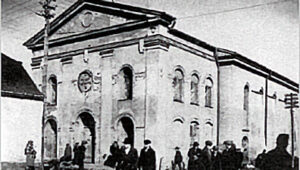 |
“In the years 1928-29, Perec Willenberg undertook the design and renovation of the Old Synagogue in Częstochowa. His passion was to create a Jewish style in painting. He created works using stylised Hebrew characters, which he applied to the multi-coloured ceilings of synagogues in Częstochowa and in Piotrków Trybunalski. He also created stained-glass windows and flooring in this style.” – “Perec Willenberg” by his son Samuel Willenberg
Pics right: photographs of Perec Willenberg and his art in the Częstochowa Old Synagogue: |
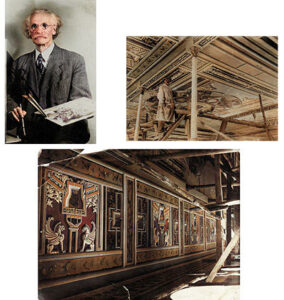 |
2 z”l – “may his memory be blessed”
3 About the existence of the flags – “History of the Jews of Częstochowa”, Vila Orbach, published by the Association of Częstochowa Jews in Israel, Tel Aviv, 2000, pp. 31-32.
4 About the existence flags: The Book of Częstochowa (Częstochowa, Poland), Chapter about “Jewish Częstochowa and its History”
5 “Goniec Częstochowski”, 7th May, 1916, p.1, “ Echa 3 Maja” (See translation below)
6 “Echoes of 3rd May”
In the Synagogue
On May 2nd at noon, in the presence of the Municipal Authority, the City Council, representatives of important institutions and the press, with the participation of Rabbi Asz, Rabbi Isajewicz, Cantor Fiszel and members of the Jewish Community Council Messrs. Markus Henig, Henryk Markusfeld, Fabj. Zorski, Jak Helman, L. Tempel, Dr. Wladysław Zachs, St. B. Helman, Iz. Freund, St. Weinberg and eng. Gustaw Kohn a service was held in the New Synagogue within the city walls. The temple was flooded with lights, flowers, greenery and white- red decorations. The most eye-attracting elements were the previously mentioned two Polish flags, with the white Polish Eagle elaborately embroidered with gold and silver on them.
Polish Eagles
The story of these objects is quite peculiar. During Napoleon’s retreat from Moscow, i.e, 104 years ago, officers were quartered, at the time, in our town’s only inn, located in the Stary Rynek, “Red House”, Blum’s Inn. When the alarm of the enemy approaching was raised, the Frenchmen and, together with them, the Poles abandoned the town leaving behind the two banners. The innkeeper hid them from the Russians and harbored them for a long time until, during the 1868 uprising, they appeared as “puroches”, i.e., scroll curtains in the Old Synagogue at the corner of ul, Prosta and ul. Garncarska. Hebrew words stitched on the silk testified that the two-sided flag was donated by Dobra, daughter of Nachman and wife of Majer Blum and that the one-sided one was donated by Chaja wife of Jozef Hejman. Both women belonged to the Blum family, one as a daughter and the other one as a daughter-in-law. They harbored these precious objects during the times when Cossacks and the Russian Army were searching the throughout the Kingdom until during the fiercest battles of the 1868 uprising:
“Boże coś Polskę”
After the suppression of the uprising, the flags were hidden by one of the most notable Jewish families until, after sixty-eight years, on 3rd May 1916, they again saw the light of the day. It seemed that the banners’ eagles awoke again and with their wings aflutter, gazing towards the approaching dawn of freedom. And again, after the service, Polish anthems “Boże coś Polskę” and “ Z dymem pożarów” were sung under the direction of Mr. M. Steinfeld
7 The New Synagogue was built, in 1893, on the corner of ul. Wilsona (formerly ul. Aleksandrowska) and ul. Garibaldiego
8 Poland Celebrates the Sesquicentennial of U.S. Independence, 1926: Part I https://text-message.blogs.archives.gov/2017/07/18/poland-celebrates-the-sesquicentennial-of-u-s-independence-1926-part-i/
9 Poland Celebrates the Sesquicentennial of U.S. Independence, 1926: Part II https://text-message.blogs.archives.gov/2017/07/19/poland-celebrates-the-sesquicentennial-of-u-s-independence-1926-part-ii/
10 The Book of Częstochowa (Częstochowa, Poland), Chapter about “The Jewish Community and the Municipal Institutions by David Koniecpoler”
11 The Old Synagogue was ravaged by the Germans, aided by a Polish mob, on 25th September 1939. In 1943,the Nazis completely destroyed it during the liquidation of the “Small Ghetto”.
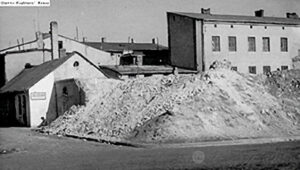 The New Synagogue was set on fire by German military policemen, assisted by their Volksdeutsch henchman on Christmas Day, 25th December 1939.
The New Synagogue was set on fire by German military policemen, assisted by their Volksdeutsch henchman on Christmas Day, 25th December 1939.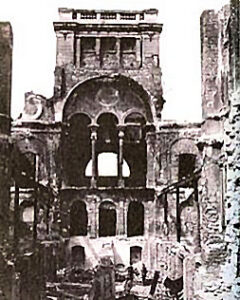
12 The USHMM has a very similar photo .
January 1945, Czestochowa. Photo Credit USHMM
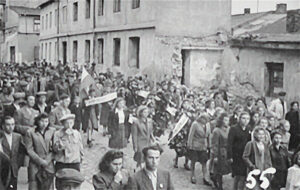 Jewish survivors in Częstochowa march along ul. Spadkowa-Kozia in protest against the way Jewish victims of German actions in the small ghetto were buried in mass graves filled with lime.Jewish survivors in Czestochowa march along Spadkowa-Kozia Street in protest against the way Jewish victims of German actions in the small ghetto were buried in mass graves filled with lime. Hela and Jack Shipper are pictured in the foreground in the centre. As a result of the protest, the bodies were exhumed and buried in the Jewish cemetery in Częstochowa. Among the victims were the donor’s brother, Leib Shipper, his sister, Yentel (Shipper) Owieczko, and her daughter, Hela.
Jewish survivors in Częstochowa march along ul. Spadkowa-Kozia in protest against the way Jewish victims of German actions in the small ghetto were buried in mass graves filled with lime.Jewish survivors in Czestochowa march along Spadkowa-Kozia Street in protest against the way Jewish victims of German actions in the small ghetto were buried in mass graves filled with lime. Hela and Jack Shipper are pictured in the foreground in the centre. As a result of the protest, the bodies were exhumed and buried in the Jewish cemetery in Częstochowa. Among the victims were the donor’s brother, Leib Shipper, his sister, Yentel (Shipper) Owieczko, and her daughter, Hela.
13 Polish Army’s Chief Rabbi, Dr. Dawid Kahana – Czestochowa Yizkor Book page 358
14 Zvi Szpalten was born in Częstochowa, in 1892, to Shraga Fajwel and Lea Liberman. He married Henia Fiszman. The couple lived in Czestochowa with their three boys – Solomon (b.1923), Szraga Fajwel (b.1927), named after Tzvi’s father and. Eliezer (b.1930), named after Tzvi’s grandfather. On 1st October 1942, Henia and the three boys were fatally shot in Częstochowa. Zvi was in HASAG Częstochowianka during the war – he survived the Holocaust and immigrated to Israel. Zvi remarried in Israel to Malka Landau nee Szwarcbaum. Before the Holocaust, Malka was married to Icek Szlomo Landau – they had a son Henryk Landau. Icek Szlomo Landau and their son were murdered by the Nazis. Zvi was industrialist and was active in Częstochowa communal life. In Israel, Zvi joined the publishing committee for the publication of a Częstochowa memorial book.The Częstochowa Yizkor Book contains a chapter, written by him,.entitled Rescue Committee for Refugees from Germany by Tzvi. Szpalten, F. Szmulewicz. Another chapter tells about his activities, Industry in Częstochowa– Its Creation and Development by Jakob Lewitt. A tombstone in memory of the descendants of Zvi’s parents, Fajwel Szpalten and Leja Liberman, and their family stands in Częstochowa Cemetery. Zvi Szpalten died on 1st December 1982 in Holon, Tel Aviv. His second wife, Malka, died on 8th December 1990 in Holon, Tel Aviv. We do not know how did Tzvi Szpalten obtained the small Parochet and when he donated it to Israel Museum in Jerusalem.
15 The Gidonim Project – www.gidonim.com. For many years, historian Wiesław Paszkowski, of the Częstochowa Museum Documentation Centre, has studied the history of the cemetery and its graves. In 2012, he published the first volume of the Polish guide to the Jewish Cemetery of Częstochowa.The Gidonim Project is a unique undertaking by students of Reut High School in Jerusalem, under the leadership of the teacher Dina Weiner. The students travel to Poland every year since 2004, to restore, photograph and document graves in Jewish cemeteries in Poland. Between the years 2008 and 2016, Alon Goldman, Chairman of the Association of Częstochowa Jews in Israel, helped to raise funds to renovate the Częstochowa Jewish Cemetery. In 2018, Alon Goldman integrated the data from the mapping conducted by the historian Wiesław Paszkowski with the mapping created by the Gidonim and the results of the work were uploaded to the Gidonim website, which can be searched in HEBREW or ENGLISH.
16 Czestochowa-Radomsko Area Research Group – https://www.crarg.org/
17 Salomon Blum was from a small place, Szczepocice. The place does not appear in the book Where Once We Walked, A Guide to the Jewish Communities Destroyed in the Holocaust. It appears twice in Wikipedia:
- Szczepocice Prywatne is a village in the administrative district of Gmina Radomsko, within Radomsko County, Łódź Province, in central Poland.It lies approximately 10 kilometres south-west of Radomsko and 86 km south of the regional capital Łódź.
- Szczepocice Rządoweis a village in the administrative district of Gmina Radomsko, within Radomsko County, Łódź Province, in central Poland. It lies approximately 9 kilometres south-west of Radomsko and 85 km south of the regional capital Łódź.
18 Częstochowa Marriage Record of Abram Majer Szczekacz and Mirla Blum (Literal translation of record #26 film 1659507):
In Częstochowa, town twenty-first June / third July, eighteen seventy-eight year at six o’clock afternoon [21 Jun / 3 Jul 1878 at 6:00 PM]. It was affirmed that, in the presence of witnesses Aba Pelc, teacher fifty-five years old, and Lajzer Besser, servant forty-nine years old, both resident in Częstochowa, a religious marriage between Abram Majer Szczekacz, twenty-three years old born Częstochowa, son of Berek trader and Hana nee Szmidt, living with parents in Częstochowa, and Mirla Blum, unmarried, born in Częstochowa, daughter of Jonas trader and Marianna nee Rundsztejn, twenty-one years old, living with parents in Częstochowa. The marriage was preceded by three announcements in the local synagogue on twenty-fifth May, third and eighth June current year as confirmed by present certificates. The newlyweds declare that they do not have a marriage [pre-]agreement. The religious marriage ceremony was performed by Dawid Weksler, acting as Rabbi of Częstochowa District. This record was read all present and signed, with the exception of Lajzer Besser and the newlyweds – they were declared illiterate.
19 Abram Majer died in 1913 – his grave stands in Częstochowa cemetery:
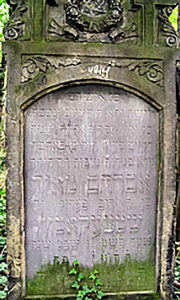 |
First Name: Abraham Meir Father: Dov Berl Spouse: Miriam Blum Last Name: Szczekacz Date of Death: 15.1.1913 Remarks: Brothers next to each other. Lot No. 4, Row No. 8, Position in Row 14, Tombstone ID: 4814, ID according to Paszkowski: 843 11 H. ID According to Yaari: 2070 |
20 “Marriage banns” are announcements of a marriage, usually made at weekly intervals. Normally, there are three of these announcements, made at the synagogue of the groom and the synagogue of the bride.
21 Josef Kuperman – death record – Częstochowa Births, Marriages, Deaths 1826-84: 1831, Death record No.31 Registration Date: 3rd August 1831 film 875326: Death Date: 14th July 1831, in Częstochowa. Deceased: Josef Kuperman, age 45. His spouse: Haja. Witness 1: Salomon Blum, Częstochowa. Witness 2: Abraham Szacher, 38, hospital worker, Częstochowa. Witness 3: Mojżes Landau, 59; The Deceased left a daughter Bayla.
22 “Jewish Wills from Częstochowa and the Vicinity as Historical Sources for a Study of the Jewish Life in the First Half of the Nineteenth Century”, Dariusz Złotkowski
23 The Blum Family Tree – it is important to note that some of Salomon and Bayla’s children died before the will was written.
24 According to note 56 in the article: Neither the testator’s (Haja Hayman-Kuperman nee Lewkowicz) birth nor death dates have been found in any records at Częstochowa ASC (registry). She did not remarry in the period in question. Her death was not reported either. She might have died of cholera and was buried hastily without proper formalities.
25 According to note 57 in the article: He (Josef Kuperman) died at 65 (according to his death record, he died at age 45), on 14th July 1831, at noon. His demise was reported by Salomon Blum on 3rd August 1831 with witnesses: Jozef Salten(?) age 40, and Mojżesz Landau, 59. The record includes information on the remaining family: his daughter Bayla, Mrs. Salomon Blum, and his wife, Haya. (Częstochowa Births, Marriages, Deaths Records 1826-84)
26 Meir Blum (son of Salomon Blum) Grave(1828-1911):
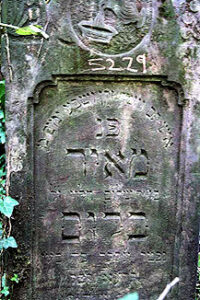 |
Meir Blum Son of Shalom Hallevi Spouse Freida Cohen (Fajgla Brat) Died on 21 June 1911
|
27 Jonas Blum – one of Salomon’s children was Jonas Blum (1822-1909), who was also an innkeeper. Jonas was married twice. His first wife was Estera Tenenbaum (1818-1855), with whom he had three children: Haja Itta, Nucha and Salomon. His second wife was Rayzla Rundsztein (1829-1905), with whom he had five children: Mirla Miriam, Hendla, Chim, Dwora and Temara. Rayzla had been married before to Dawid Blumenfeld (???-1854). Jonas was her second husband. She had a daughter from her first marriage – Chana Blumenfeld.
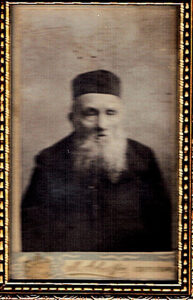
Jonas Blum |
The Grave of Jonas Blum in Czestochowa Cemetery Yona son of Shalom Halevi, married to Reizel Rondshein Death Date: 17 April 1909 Lot No.: 5, Row: No. 7, Position in Row: 19 Tombstone ID:5719 ID according to Paszkowski: 519 11 H ID according to Yaari: 2173 |
Source:
The Webmaster gratefully
acknowledges the author
of this article
RUTH WILNAI
and
ALON GOLDMAN
who was instrumental in arranging for it to appear
on our website.
Pre-War & Wartime Maps of Częstochowa
Pre-War & Wartime Maps of Częstochowa
Source: Emanuel Ringelblum Jewish Historical Institute (ŻIH)
To view each map, simply click on the icon next to its description.
SOURCE:
The archives of the
Emanuel Ringelblum
Jewish Historical Institute (Żydowski Instytut Historyczny)
in Warsaw
IMPORTANT NOTICE
The maps on this page may not, either in part or as a whole, be distributed or published without the prior written permission of the Emanuel Ringelblum
Jewish Historical Institute.
"Częstochower Cajtung" ("Częstochowa Gazette")
ABOUT THIS PROJECT:
In one very important aspect, we believe that translating newspapers can be more revealing than translating Yizkor Books. Yizkor Books were written by Holocaust Survivors, sometimes many years after the War, relying on memories which, over time, may no longer be as accurate as we would like and which may have been affected by “collective memory”. However, newspapers were written in “REAL TIME”, as events, being written about, were actually happening.
The “Częstochower Cajtung” (“Częstochowa Gazette”), published from 1922 to 1939, was a Yiddish-language, political and social weekly, with a Zionist-Orthodox character.
Owned and printed by Bernard Bocian, it was initially edited by Izrael Płocker and then by Szmul Frank. Its editorial office was located at Aleja NMP 6.
It seems to have been the most enduring periodical of Jewish Częstochowa. This was probably due to its moderate political line.
It had a sound financial position which was drawn from both advertising and subscriptions. It was printed in its own (Bocian’s) printing house.
Its circulation ranged from 900 to 1,400 copies and continued to be published weekly until the last week of August 1939.
In translating the issues of this newspaper, every effort has been made to translate, as accurately as possible, the Yiddish text and to transliterate (and double-check) the names of people and places as they would have been spelt in a historically, accurate manner (surnames may have been changed post-War). This includes the use of Polish diacritics where appropriate.
PLEASE NOTE: A great number of people are mentioned in the issues of this Yiddish newspaper.
If anyone finds their landsleit relatives’ names spelt incorrectly, please email us.
We have decided to begin translating these newspapers with 1939 – the year when the Germans marched into Częstochowa. We believe that, unlike the Yizkor Books, which were published post-WWII,
they will provide us with knowledge about what the Częstochowa Jewish community knew at the time.
We believe that this is the first time
that there has been an attempt to PROFESSIONALLY translate, into English,
as many issues as possible of this Częstochowa Jewish newspaper.
The professional English translation of this newsapaper has been made possible by the financial support of the
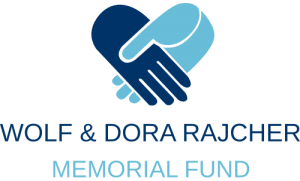
Wolf Rajcher z”l and Dora Rajcher z”l were both Holocaust survivors from Częstochowa.
They were prisoners in both the “Big Ghetto” and the “Small Ghetto” and, until liberation, were slave labourers in HASAG-Pelcery. Following the War, they emigrated to Melbourne Australia.
Upon the passing of both his parents, their son, Andrew Rajcher, established this charitable fund in their memory.
Click on the YEAR to reveal that year’s issues.
-
1939 – 34 issues (12 issues translated into English thus far)
ENGLISH TRANSLATION:
David Horowitz-Larochette
IMPORTANT NOTICE
While the English translations are available for download, they may not, either in part or as a whole, be distributed or published without the prior written permission of Andrew Rajcher, the copyright-holder of this English-language version of this newspaper.
The Exhibition: Seton Hall University, New Jersey
Exhibition Showing: Seton Hall University, New Jersey, USA
22nd January - 2nd April 2006
 Seton Hall’s Walsh Library, built in 1994 and located in the heart of the campus, is a four-storey, 155,000 square-foot structure, named in honour of the Board of Regents Chairman and University benefactor Frank E.Walsh and his wife, Mary D.Walsh.
Seton Hall’s Walsh Library, built in 1994 and located in the heart of the campus, is a four-storey, 155,000 square-foot structure, named in honour of the Board of Regents Chairman and University benefactor Frank E.Walsh and his wife, Mary D.Walsh.
 Seton Hall University is one of the leading Catholic universities in the USA and is home to the Sister Rose Thering Endowment. Through the initiative of Sister Rose* herself, aided by our very own Alan Silberstein, an Endowment Board member, that the Jews of Częstochowa” came to Seton Hall.
Seton Hall University is one of the leading Catholic universities in the USA and is home to the Sister Rose Thering Endowment. Through the initiative of Sister Rose* herself, aided by our very own Alan Silberstein, an Endowment Board member, that the Jews of Częstochowa” came to Seton Hall.
On Sunday, 22nd January, almost 300 people were welcomed to the Official Opening of the Exhibition by Luna Kaufman, Chairman of the Board of the Sister Rose Thering Endowment and Associate Professor Dr.Richard Stern, representing the Walsh Library.
Guests were entertained by Cantor Daniel Neiden who sang excerpts from Virgilio’s Prayer and The Voyage of the Black Madonna by John La Barbera.
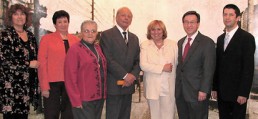
From left: Jo Ann Cotz (Exhibition Curator at Seton Hall),
Marilyn Zirl (Endowment Administrator),
Luna Kaufman, Sigmund Rolat,
Lea Wolinetz,
Alan Silberstein,
Consul Marek Skulimowski




Deputy Polish Consul in New York City, Marek Skulimowski, spoke briefly followed by the Exhibition’s Sponsors Alan Silberstein and Sigmund Rolat. Lea Wolinetz, Chief Exhibition Coordinator and a second-generation Częstochowianka, gave a short address and closed the official part of the Opening.



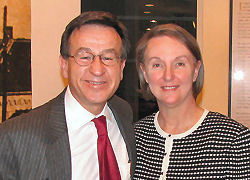
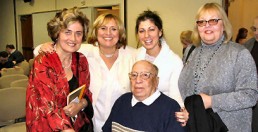
From left: Elizabeth Mundlak, Lea Wolinetz, Sam Bida (from Częstochowa),
his granddaughter and daughter Anna Bida Fleischer
* Sister Rose Thering, O.P., Ph.D., Professor Emerita at Seton Hall, is a Dominican nun who has dedicated her life to preserving the historical link and advocating the common purpose of Jews and Christians throughout the world. The Sister Rose Thering Endowment was established in 1993 in her honour to help provide scholarship assistance for teachers to take graduate level courses in Jewish Christian and Holocaust studies. It also develops curricular resources and presents workshops for teachers in public, private and parochial schools. More than 350 teachers and an estimated 150,000 students throughout New Jersey have benefited from the endowment since its inception.
Seton Hall University, nationally known and respected as a leading Catholic university, embraces students of all races and religion. For nearly 150 years, Seton Hall has been a catalyst for leadership, developing the whole student, mind, heart and spirit. It combines the resources of a large university with the personal attention of a small liberal arts college.
The Webmaster wishes to thank Alex Wolinetz and Iwona Hoffman
for the photographs that appear on this page.
The Exhibition: New York City, New York
Exhibition Showing: New York City, New York, USA
2nd-10th November 2005
 The venue for the “Jews of Częstochowa” exhibition in New York City was the Consulate General of the Republic of Poland which is housed in a magnificent mansion that was once the home of banker J.P.Morgan.
The venue for the “Jews of Częstochowa” exhibition in New York City was the Consulate General of the Republic of Poland which is housed in a magnificent mansion that was once the home of banker J.P.Morgan.
 Built in the 1880’s, it is an elaborate Neo-classical French-style building with gilded mouldings, a graceful winding staircase and a beautiful painted ceiling in the ballroom.
Built in the 1880’s, it is an elaborate Neo-classical French-style building with gilded mouldings, a graceful winding staircase and a beautiful painted ceiling in the ballroom.
The official opening, held on Thursday, 3rd November, was attended by over 350 people.
After his formal remarks (in English), Shewach Weiss (pic right) could not help exclaiming (in Polish) how unbelievable it was for him to be standing there considering that he is a Holocaust survivor who became the Ambassador of the State of Israel to Poland and an honoured guest at an occasion hosted by the Polish Consul-General.




Other speakers at the opening included (from left) Sigmund Rolat (a sponsor of the Exhibition), Prof. Dr. hab. Jerzy Mizgalski (Curator of the Exhibition),
Prof.Feliks Tych (President, Jewish Historical Institute in Warsaw) and Dr.Tadeusz Wrona (President, City of Częstochowa).


Among guests invited from Poland were Rabbi Michael Shudrich (Chief Rabbi of Poland)
and Halina Wasilewicz (Chairwoman of TSKZ, Częstochowa).
Since the showings in Poland, the addition of the Polish students’ artwork to the Exhibition was powerful proof that it had reached and inspired a new generation in Poland to consider the role of Jews in their country’s history.
All Polish art schools now have the compulsory study of art “inspired by Jewish culture”. Also, the study of the Jews and the Holocaust is now compulsory study for students in all Polish high schools.
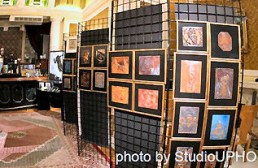

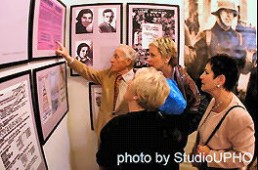
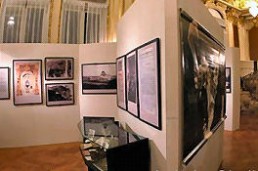
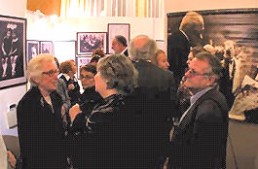
and also Sylvia Safer, Prof. Dr.Jerzy Mizgalski and Piotr Stasiak for their input.
The Exhibition: Houston, Texas
Exhibition Showing: Houston, Texas, USA
11th February - 29th July 2007
 The Mincberg Gallery at the Holocaust Museum Houston, Morgan Family Centre, was the next home for our Exhibition on its tour around North America.
The Mincberg Gallery at the Holocaust Museum Houston, Morgan Family Centre, was the next home for our Exhibition on its tour around North America.
Since March 1996, the Museum’s mission has been to educate students and the public about the dangers of prejudice and hatred in society, focusing on the stories of Holocaust survivors living in the Houston metropolitan area.
The Official Opening of our Exhibition was attended by over 200 people representing many areas of Houston society and showed that the reputation of Texan hospitality was no exaggeration. The cocktail reception and Opening proceedings were conducted to perfection.
Our Częstochowa Exhibition was in illustrious company. It shared the limelight with the presigious Scream the Truth at the World – Emanuel Ringelblum and the Hidden Archive of the Warsaw Ghetto exhibition. Both were on view in the Mincberg gallery at the Museum until 29th July 2007.




The following morning saw a wonderful training session for the docents of the Museum. After all, what’s a successful Exhibition without docents? Sigmund gave a personal tour through the Exhibition and, with his usual charismatic style, motivated the group to tell our story to groups who would visit our exhibition over the following months.




The Webmaster wishes to thank Lea Wolinetz for the words and Marilyn Levin for the photographs from which this page was compiled.
The Exhibition: Fort Lauderdale, Florida
Exhibition Showing: Fort Lauderdale, Florida, USA
3rd December 2006 - 29th January 2007
 The Alvin Sherman Library Gallery at Nova Southeastern University in Fort Lauderdale, Florida was the next stop for our Exhibition, The Jews of Częstochowa.
The Alvin Sherman Library Gallery at Nova Southeastern University in Fort Lauderdale, Florida was the next stop for our Exhibition, The Jews of Częstochowa.
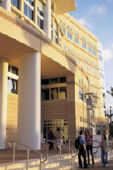 It was accompanied by the lnspired by Jewish Culture” art project, motivated by the Exhibition and created by students of the Malczewski School of Fine Arts in Częstochowa and throughout Poland.
It was accompanied by the lnspired by Jewish Culture” art project, motivated by the Exhibition and created by students of the Malczewski School of Fine Arts in Częstochowa and throughout Poland.
 Nova University is located on a beautiful 300 acre campus and has more than 25,000 students. It is the largest institution of higher education in the south-east and the sixth largest independent institution nationally. The Alvin Sherman Library, Research, and Information Technology Center is central to the University’s main campus – Fort Lauderdale.
Nova University is located on a beautiful 300 acre campus and has more than 25,000 students. It is the largest institution of higher education in the south-east and the sixth largest independent institution nationally. The Alvin Sherman Library, Research, and Information Technology Center is central to the University’s main campus – Fort Lauderdale.
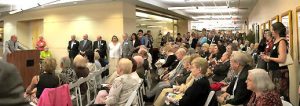 The Exhibition Opening was held on Sunday 3rd December in the Libary before over 300 Landsleit and their friends, with representatives of the Hebrew College, David Posnack JCC, Nova Southeastern University and the Holocaust Documentation and Education Center in Miami also in attendance.
The Exhibition Opening was held on Sunday 3rd December in the Libary before over 300 Landsleit and their friends, with representatives of the Hebrew College, David Posnack JCC, Nova Southeastern University and the Holocaust Documentation and Education Center in Miami also in attendance.

 Master of Ceremonies for the event was Dr Irv Rosenbaum, Vice-Chancellor, NSU Health Professions Division (pictured left), who welcomed everyone to the Exhibit and expressing how pleased the University was to host it.
Master of Ceremonies for the event was Dr Irv Rosenbaum, Vice-Chancellor, NSU Health Professions Division (pictured left), who welcomed everyone to the Exhibit and expressing how pleased the University was to host it.
World Society President, Sigmund Rolat, thanked Nova University for hosting our Exhibition and, in welcoming the many guests, noted with great pleasure the exceptional number of Częstochowa landsleit who were present at the Opening of this Exhibition.
Dr Rosenbaum also stated that this was the first event of its kind to be held in Nova University and said that there were plans for future Jewish-related events on campus in the near future.

 World Society Board Member,Alan Silberstein (pictured left), spoke of his experiences as a child of Holocaust survivors from Częstochowa. World Society Executive Director, Lea Wolinetz (pictured right), spoke of the special bond that we have to Częstochowa and our heritage and promised the survivors that their story will never be forgotten.
World Society Board Member,Alan Silberstein (pictured left), spoke of his experiences as a child of Holocaust survivors from Częstochowa. World Society Executive Director, Lea Wolinetz (pictured right), spoke of the special bond that we have to Częstochowa and our heritage and promised the survivors that their story will never be forgotten.
Other speakers at the Opening Polish-Jewish historical and social commentator Konstanty Gebert, President of the Holocaust Documentation and Education Center Harry A Levy and Director,Southeast Region, Hebrew College, Harold Wishna.



Mrs Rositta Kenigsberg, Executive Vice-President of the Holocaust Documentation and Education Centre, who was instrumental in helping us bring the Exhibition to Nova University, urged survivors present to contact the center and give a “living testimony”. Many of our Landsleit have already agreed to tell their stories to the Museum in Miami.




The Exhibition: Detroit, Michigan
Exhibition Showing: Detroit, Michigan, USA
16th July - 29th August 2006

 The first freestanding museum in the United States dedicated to the memory of the Holocaust, The Holocaust Memorial Center, in Detroit Michigan, was the venue for “The Jews of Częstochowa” exhibition in Detroit.
The first freestanding museum in the United States dedicated to the memory of the Holocaust, The Holocaust Memorial Center, in Detroit Michigan, was the venue for “The Jews of Częstochowa” exhibition in Detroit.
A gathering of 300 people attending the Opening of the Exhibition on Sunday 16th July, with Detroit’s Fox TV Channel 2 journalist, Lila Lazarus (pic right), as Master of Ceremonies. Two days earlier, Lila had interviewed Sigmund Rolat live on her news program.
 Other speakers at the Opening included Michigan Congressman Joe Knollenberg, Pawel Pietrasienski, Deputy Consul-General of the Republic of Poland in Chicago, and Ralph J.Gerson, a prominent Detroit area resident and President & Chief Executive Officer of Guardian International Corp. – a American company which has established a manufacturing plant in Częstochowa.
Other speakers at the Opening included Michigan Congressman Joe Knollenberg, Pawel Pietrasienski, Deputy Consul-General of the Republic of Poland in Chicago, and Ralph J.Gerson, a prominent Detroit area resident and President & Chief Executive Officer of Guardian International Corp. – a American company which has established a manufacturing plant in Częstochowa.




 World Society Executive Director, Lea Wolinetz, stressed the responsibility of Second Generation Landsleit to preserve the story of our forebears for future generations. She described the formation of the World Society as a direct outgrowth of this Exhibition and of the website – none of which would have happened without Sigmund Rolat’s energy and commitment.
World Society Executive Director, Lea Wolinetz, stressed the responsibility of Second Generation Landsleit to preserve the story of our forebears for future generations. She described the formation of the World Society as a direct outgrowth of this Exhibition and of the website – none of which would have happened without Sigmund Rolat’s energy and commitment.
Dr Thaddeus Radzilowski, Ph.D., President of the PIAST Institute, represented the local Polish-American community.
Others to speak included Rabbi Charles H. Rosenzveig, from the Holocaust Memorial Center and, of course, our own Sigmund Rolat and Alan Silberstein, sponsors of the exhibition.




The exhibition was prominent in the local media with theDetroit Free Press, the Detroit Jewish News and the Kalamazoo Gazette all running feature articles. Also, the Polish Weekly featured the exhibition in both English and Polish.
Sigmund Rolat appeared on television, interviewed live by both FOX TV and ABC and his documentary, As If It Were Yesterday has been aired on PBS (Detroit Public Television).
for the information from which this page was compiled.
The Exhibition: Washington D.C.
Exhibition Showing: Washington, D.C., USA
5th-9th December 2005
 The venue for the “Jews of Częstochowa” exhibition in Washington DC was the Russell Senate Office Building, built between 1903-1908.
The venue for the “Jews of Częstochowa” exhibition in Washington DC was the Russell Senate Office Building, built between 1903-1908.
Named after Senator Richard Brevard Russell, Jr., a Democrat from Georgia (served 1933-1971), it is the oldest of the US Senate office buildings and is a significant example of the Beaux Arts style of architecture.
 Despite the snowy, winter weather, around 80 VIP guests attended the Official Opening of the Exhibition.
Despite the snowy, winter weather, around 80 VIP guests attended the Official Opening of the Exhibition.
 Elizabeth Mundlak, the great-granddaughter of Rabbi Asz from Częstochowa, opened with a short speech. She thanked Dr Jerzy Mizgalski and Sigmund Rolat for helping her to realize her dream.
Elizabeth Mundlak, the great-granddaughter of Rabbi Asz from Częstochowa, opened with a short speech. She thanked Dr Jerzy Mizgalski and Sigmund Rolat for helping her to realize her dream.
Sigmund Rolat welcomed Stephen Solarz, former US Congressman from New York, who then introduced the featured speaker for the Opening, Christopher R.Hill, Assistant Secretary of State for East Asian and Pacific Affairs, and former US Ambassador to Poland and to the Republic of Korea.


Acting Polish Ambassador to the USA, Dr.Boguslaw Winid (l), and Alan Silberstein (r) also addressed the assembled guests.

Invited guests included representatives from the Polish, Russian and French embassies, high-ranking officials from the US Holocaust Memorial Museum as well as representatives from numerous organisations such as 2nd Generation, Jewish War Veterans and Jewish Women International.
Numerous Holocaust survivors and representatives from Congressional and Senate offices were also present as did members of both the Polish and American press.
the Polish and American press.
Lea Wolinetz and her docents spoke with the many visitors, distributed brochures, DVD’s, albums, postcards and catalogues. Not only did the invited guests view the Exhibition, but also people who work people within the building and as well as visitors to the building (for business or pleasure).
Even the current Iraqi ambassador to the USA spoke with Lea and expressed his interest in the Exhibition.

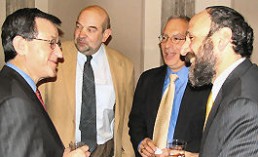
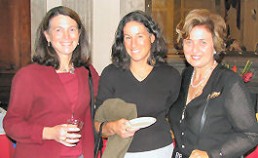
The Webmaster wishes to thank Iwona Hoffman for the photographs that appear on this page.
The Exhibition: Cincinnati, Ohio
Exhibition Showing: Cincinnati, Ohio, USA
22nd April-1st July 2012
 After a lengthy break, our Exhibition went on show again, this time in Cincinnati at the Skirball Museum, within the beautiful grounds of Hebrew Union College.
After a lengthy break, our Exhibition went on show again, this time in Cincinnati at the Skirball Museum, within the beautiful grounds of Hebrew Union College.
The opportunity for our Exhibition to go on show in Cincinnati was, in no small measure, due to the efforts of The Centre for Holocaust & Humanity Education, its Executive Director, Sarah Weiss, and her wonderful staff.
The Centre’s mission is to educate about the Holocaust, remember its victims and act on its lessons. Through innovative programs and partnerships, The Centre challenges injustice, inhumanity and prejudice, while fostering understanding, inclusion and engaged citizenship.
The Official Opening of our Exhibition was attended by around 200 people representing Cincinnati’s Jewish, Polish and general communities. Among those who spoke at the Opening were our President Sigmund Rolat, our Executive Director Lea Wolinetz, the Exhibition’s creator Prof. Dr. hab.Jerzy Mizgalski, the Mayor of Częstochowa Krzysztof Matyjaszczyk, the Exhibition’s co-sponsor Alan Silberstein, the Polish Consul-General in New York Ewa Junczyk-Ziomecka and Sigmund’s grandson Henry Rolat-Asulin.
In the lead-up to the Exhibition’s Opening, the Częstochowa visitors were treated to Shabbat Dinner at Xavier University (our thanks to Rabbi Abie Ingber), a tour of the University of Cincinnati (our thanks to Dr.Mitchel Livingston), a tour of the American Jewish Archives (our thanks to Dr.Gary Zola), a tour of The Centre for Holocaust and Humanity Education (our thanks to Sarah Weiss) and a visit to the National Underground Railroad Freedom Center .
Also, to those who invited us into their homes and showed us immense hospitality,
and to the people of Cincinnati who welcomed us so warmly, we say
THANK YOU!
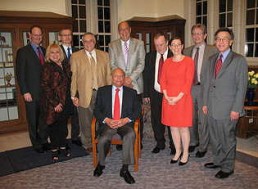
On the Friday evening, before the Exhibition Opening, we were guests of Xavier University for a Shabbat dinner hosted by Rabbi Abie Ingber.
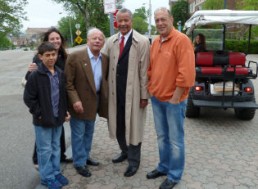
The following day, Dr.Mitchel Livingston gave us a tour of Sigmund’s old alma mater, the University of Cincinnati.
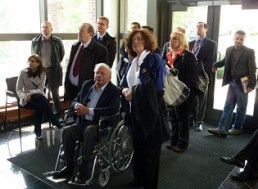
On the morning of the Exhibition Opening, we were given a tour, by Dr Gary Zola, of the magnificent records held by the American Jewish Archives.

